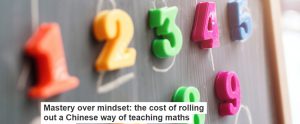
The complete title of this article is ‘Mastery over mindset: the cost of rolling out a Chinese way of teaching maths’. Do read this article first published on www.theconversation.com about the ‘new’ way of teaching maths as they do in China and let us have your thoughts.
Half of primary schools in England will receive £41m over four years to teach mathematics using a method called the “mastery approach” that is used in Chinese schools. Yet during the last ten years many primary schools in England have started embracing another method, called the “mindset approach”, which is supported by 30 years of psychological research in the US and more recently in the UK.
While the mastery model breaks down learning into small goals which have to be achieved before moving on, the mindset maths model aims to get pupils to develop an intuitive understanding of mathematical concepts before learning formal procedures such as addition or multiplication. Can the two work together in schools to help young children learn maths?
Mindset is about motivation
Mindset theory has established that each person has ingrained beliefs regarding each subject, which pre-determine whether learning the subject will be successful. Carol Dweck, the most prominent researcher in this field, has demonstrated spectacularly that a wrong kind of environment can destroy a learner’s motivation, possibly with long-lasting effects.
Vice versa, it is possible to build learning environments which nurture a learner’s motivation and so make learning possible. Mathematics, a subject which is often portrayed as difficult in the media, has immediately attracted the attention of researchers, and a number of principles have evolved for developing classroom environments which are conducive to learning mathematics.
One thing that proponents of both the mastery and mindset theory (about teaching maths) agree with is avoiding the idea that a child can have a gift for maths so that high expectations are set for all pupils. According to mindset theory, a learner’s belief that they are or are not talented is a dangerous illusion, which damages their progress.
Some of the suggestions for organising in-class activities are similar in the mastery and mindset approaches. For example, all pupils spend the same period of time working on the same problem, rather than some pupils racing forward to the next problem. This may involve some pupils starting work, perhaps unsuccessfully, on some deeper or more general versions of the problem.
A shortcut to maths concepts
While on the surface the mastery approach talks of a curriculum designed to enable deep conceptual, as well as procedural, knowledge, a look at its principles and sample lessons reveals undue concentration on numerous rigid objectives, achieved in a strict linear order.
In one implementation of the mastery approach, the process of adding two numbers is split into 23 consecutive learning objectives, which all need to be mastered separately, and may be tested separately by the teacher.
Mindset approach is completely different. It aims to be more exploratory, and tends to start from the “complicated” concepts, rather than reaching them by a long path. This stems from the belief that most ideas of mathematics are not abstract, but directly correspond to what can be demonstrated by real-world models. For example, a mindset-approach teacher can introduce addition via joining two heaps of cardboard counters (or other props) together, explore properties of addition via activities, and only then break the process of adding numbers into procedural steps.
Developing number sense
Mindset approach advocates that pupils develop what is called “number sense”: an ability to choose (or invent) those methods of working with numbers which are more convenient and efficient in a particular situation.
As a simple example, a person possessing number sense will never calculate 5×3 as 3+3+3+3+3, because the process of adding threes is slower, less convenient and more prone to error than adding fives, that is, 5+5+5.
A person with a developed number sense may have gaps in the knowledge they store in their memory (for example, they will not necessarily know the whole times table by heart), but they will be effective at using the principles they have internalised. If a certain mathematical fact needs to be rediscovered because they do not remember it, they will be able to do it effortlessly. Some argue that a person possessing number sense will not have maths anxiety in their later life and, therefore, will be better prepared for learning more mathematics.
Too fast, too soon?
What is concerning at this stage is that unlike the mindset approach there is, as yet, no indication that the mastery approach is being systematically and empirically tested (for teaching maths). Only one preliminary study in the UK has been published, and it expresses only cautious optimism regarding the mastery model.
There are striking differences between mindset-approach and mastery-approach classroom activities, and we are not sure that in the long term, the mastery approach is better. The new government focus on the mastery method may also be confusing for teachers, after they have been encouraged to teach with the mindset approach.
We are left with some worrying unanswered questions – particularly as half of UK schools are now being encouraged to move to a mastery approach before any empirical evaluation of its impact on learning has taken place.
Authors:
Alexei Vernitski, Senior Lecturer in Mathematics, University of Essex
Sherria Hoskins Head of Psychology, University of Portsmouth
For more information about Tuition First’s Maths tuition, see here.
